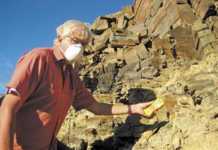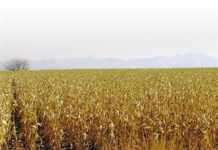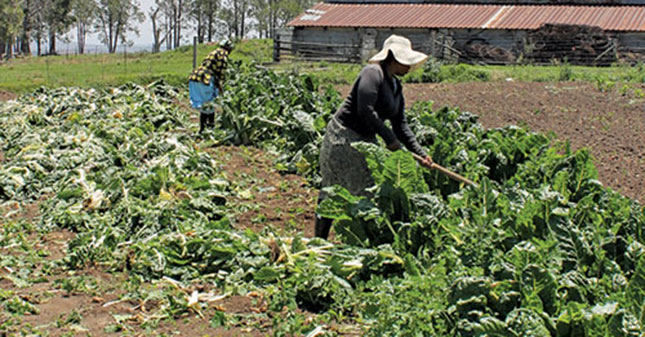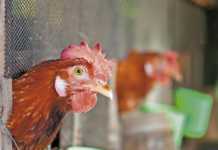
Photo: Courtesy of Prof Heinz Beckedahl
Prof Heinz Beckedahl at the University of KZN’s School of Environmental Science warns that the problem remains dire and more must be done to prevent erosion. Siyanda Sishuba spoke to him.
What is South Africa’s current soil erosion status?
Since Lindeque’s article in 2010, South Africa’s erosion problem hasn’t significantly worsened, but it has also not improved. Annually, we’re still losing an estimated 500 million tons of sediment, composed of mainly soil and topsoil.
South Africa’s soil erosion is [thus] too high, and may have a [negative] impact on future food security, as it decreases soil fertility, thereby reducing productivity.
Currently, although soil loss has decreased during the drought, ground cover loss has significantly increased, as has the potential loss of soil structure due to trampling. This is of great concern, as many areas have now become especially susceptible to soil erosion.
When the expected heavy spring rain arrives, erosion is likely to be particularly severe. Therefore, it’s extremely important that as many conservation measures as possible are established before the rain, to prevent further hardships for farmers.
To what extent have poor farming practices contributed to these problems, and can the sector somehow lessen its contribution to soil erosion?
Of course poor farming practices contribute to the erosion problem, but they are not the root cause of South Africa’s high soil loss. Most farmers are well aware
that the soil is their capital, and they wouldn’t willingly endanger their livelihoods. We need to recognise that South Africa has some highly erodible soils, coupled with very erosive rainfall characteristics. It’s therefore critical that sound conservation measures are encouraged through further government-driven initiatives.
We must also recognise the erosion potential of overgrazing and incorrect grazing practices. Thus, subsistence farmers need assistance through effective workshops to help minimise soil loss from their plots. There is a large body of literature that can assist smallholder and commercial farmers with soil conservation; the challenge is making this available to and affordable for farmers.
As urban and peri-urban agriculture also plays a role, and is likely to become even more important in the future, we must consider land in its entirety.
We must also identify areas that are particularly vulnerable to erosion, and focus on protecting these. In this regard, it’s also important to acknowledge that there have been recent advances in recognising the role of dispersive soils in the country’s degradation and soil loss.
This is particularly important, as many of the conventional conservation practices are contra-indicated for highly dispersive soils.
Can erosion and the loss of nutrients in soil increase the cost of food production? If so, why?
In 1985 and 2000, the average global hectare (gha) of arable land per person was calculated as 0,3ha (3 000m2) and 0,23ha (2 300m2) respectively. It is estimated that by 2050 this value will fall to 0,15ha (1 500m2).
While there are many reasons for this, with erosion and land degradation being only two of them, the reality is that there is
a demand for continually greater yield from less land, to the extent that more marginal land is now used for agriculture. This comes at increased input costs.
The trend in South Africa is probably more extreme, bearing in mind that the estimated erosion values for Europe are between 2t and 5t/ha/annum, whereas those for Southern Africa are between 12t and 18t/ha/annum.
However, we should be careful not to over-interpret these generalised values; site [farm location]-specific values will always be more important. The greatest threat is that soil loss and degradation are greater than rejuvenation through pedogenesis [soil formation].
Crop production is very feasible in sediments, provided there is a steady supply of nutrients, but this comes at a cost and carries the risk of water pollution by agro-chemicals.
Can conservation overcome the impact of climate change on soil erosion?
There is no straight answer to this question. In some cases, the answer would be a resounding, yes! Yet in other cases, it will not be possible. Should they be implemented, conservation measures must be viewed in relation to cost, including environmental cost. The Earth-atmosphere system is highly complex, and we should not try to over-simplify it.
We should also remember that agricultural practices will either enhance or decrease climate change through emissions, the albedo effect and the carbon sequestration by vegetation.
How is the South African government addressing the soil erosion problem?
While much is being done, more is possible. Through the Department of Environmental Affairs, government has made large sums available for soil conservation. Yet these funds are often not spent, and returned to the fiscus. This is of great concern.
It should also be remembered that there is a further line of government support through allowable tax rebates for conservation measures. These should be publicised far more than is currently the case.
Another option, which has not really taken hold despite several attempts, is to include soil conservation into poverty relief programmes, such as Working for Water. The department of agriculture, and especially the Agricultural Research Council, are actively involved in furthering the work of understanding land degradation and its rehabilitation.
Do you think Africa’s agricultural development will worsen the continent’s soil erosion problem?
The simple answer is no. Throughout the continent, agriculturalists are aware of the [soil erosion] problem and associated dangers.
I have had the good fortune of working with colleagues in several other countries, in and out of Africa, and their training emphasises the importance of soil conservation. The most common challenge is to find the funds to implement the necessary conservation measures.
In this context, it’s important to have the necessary political will for the funds to be allocated from respective national budgets.
Email Prof Heinz Beckedahl at [email protected].












